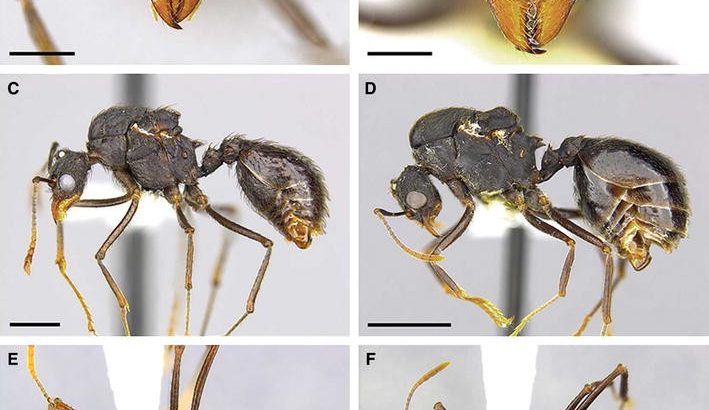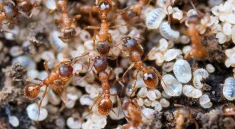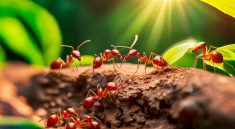Simple Machines Forum – Imagine solving a crime scene where the suspects are 5mm long, leave chemical trails instead of fingerprints, and operate in highly organized colonies. Welcome to the world of ant CSI, where researchers are using digital microscopes to uncover secrets of ant behavior that were invisible just a decade ago.
From decoding complex communication systems to tracking disease spread in colonies, digital microscopes are transforming how scientists study these tiny yet sophisticated creatures. No longer limited by the eyepiece of traditional microscopes, biologists can now record, analyze, and even share real-time ant investigations with global collaborators.
How exactly is this technology rewriting the rules of entomology? What shocking discoveries have already been made? And why does this matter beyond just understanding ants? Let’s zoom in way in on the revolution happening in labs and classrooms worldwide.
The Tools of the Trade: Digital Microscopes vs. Traditional Methods
For centuries, studying Ant CSI meant peering through optical microscopes, sketching observations by hand, and making educated guesses about behaviors that happened too quickly for the human eye to catch. But digital microscopes have changed everything.
These high-resolution devices, often no bigger than a smartphone, can capture 4K video of ants in their natural habitats. Some models even have built-in AI to track individual ants in a colony, something impossible with manual observation. Researchers at Harvard recently used digital microscopes to document never-before-seen grooming behaviors that help prevent infections in ant societies.
The key advantage? Data. Unlike traditional microscopy, digital microscopes allow frame-by-frame analysis, spectral imaging to detect chemical traces, and even 3D reconstructions of ant anatomy. This isn’t just an upgrade—it’s a whole new way of doing biology.
Case Files: The Mysteries Digital Microscopes Are Solving
One of the most exciting applications of digital microscopes is forensic entomology—studying ants to solve ecological “crimes.” Scientists are now using this tech to:
-
Map Ant Communication Networks: By recording interactions in ultra-slow motion, researchers discovered that ants use subtle antennae taps to convey different messages, essentially a “Morse code” of vibrations.
-
Track Disease Outbreaks: When a harmful fungus invades a colony, digital microscopes reveal which ants act as “first responders,” isolating sick individuals to prevent epidemics.
-
Analyze Foraging Strategies: Time-lapse microscopy has exposed how ant colonies optimize food routes with terrifying efficiency, rivaling human logistics networks.
Perhaps the most groundbreaking find came from a Berlin lab, where digital microscopes captured ants performing wound care on each other—applying antimicrobial secretions to injuries. This could inspire new medical treatments for humans.
Classroom Breakthroughs: How Students Are Joining the Investigation
This tech isn’t just for elite researchers. Affordable digital microscopes Ant CSI (some under $200) are putting ant forensics within reach of high school and college students.
In Oregon, a biology class used a USB microscope to document an ant colony’s reaction to environmental changes, publishing their findings in a citizen science journal. Other students have created YouTube channels showcasing ant behavior in mesmerizing detail, garnering millions of views.
Teachers report that digital microscopes make microbiology tangible. Instead of memorizing textbook diagrams, students can:
-
Record their own ant experiments
-
Measure microscopic structures with on-screen calipers
-
Collaborate with peers worldwide by sharing digital specimens
It’s hands-on learning that’s creating the next generation of entomologists.
The Dark Side: Ethical Dilemmas in Digital Ant Surveillance
With great magnification comes great responsibility. Some scientists warn that constant digital monitoring could stress ant colonies or alter natural behaviors. There’s also debate over how much AI should interpret ant interactions versus human observers.
Privacy isn’t just a human concern researchers must now consider:
-
Whether 24/7 colony filming disrupts natural rhythms
-
How to store vast amounts of behavioral data ethically
-
The risk of “digital poaching” where rare ant species are over-studied
These questions show how digital microscopes aren’t just tools but catalysts for bigger conversations about our relationship with nature.
A Microscopic Revolution With Macro Implications
The impact of digital microscopes on ant research echoes beyond biology labs. These tiny subjects are teaching us about:
-
Network Security (ant colonies rarely get hacked)
-
Public Health (their disease containment strategies)
-
Artificial Intelligence (decentralized problem-solving)
As the technology becomes cheaper and more accessible, we’re entering an era where anyone with curiosity and a digital microscope can contribute to scientific discovery. The ants have been hiding astonishing secrets in plain sight—we’re finally equipped to uncover them.



